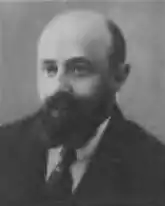Noach Pryłucki
Noach (Nojach) Pryłucki or Noach Prilutski (1 October 1882 in Berdichev – 12 August 1941 in Vilnius) was a Jewish Polish politician from the Folkspartei. He was also a Yiddish linguist, philologist, lawyer and scholar of considerable renown.[1][2][3][4] Pryłucki was a respected attorney and was said to have had "leadership over the scattered (non-Zionist) national clubs, societies, and groups".[5]

In 1910–1936, Pryłucki was the editor of the Folkist newspaper Warszawer Togblat (The Warsaw Daily), later renamed as Der Moment. In 1916 he was the founder and then became the leader of the Jewish People's Party in Poland (Folkspartei), and was elected the same year at the municipal elections (under German occupation), where the Folkspartei gained 4 seats in Warsaw. In 1918 he became a member of the Provisional Council of State of the Kingdom of Poland. Elected as a member of the Legislative Sejm in 1919, he had to resign his seat because he was not a Polish citizen. After obtaining Polish citizenship, in 1922–1927 he was reelected to the Sejm on the Bloc of National Minorities list.
Pryłucki authored numerous books on Yiddish folklore, philology, culture and theatre, published in Warsaw.[6][7] He once said of Yiddish theatre that it did not arise simultaneously with theatre in other European "national" languages; he conjectured that this was at least in part because the Jewish sense of nationality favoured Hebrew over Yiddish as a "national" language, but few Jews of the period were comfortable using Hebrew outside of a religious/liturgical context.[8]
After Soviet forces took Vilna in January 1941, he was appointed the head of the YIVO Institute.[9]
He was murdered by the Gestapo in Vilnius (Wilno) in August 1941.[10][11]
References
- "Pryłucki, Noah", YIVO Encyclopedia of Jews in Eastern Europe
- Kassow, Samuel D. (2007). Who Will Write Our History?: Emanuel Ringelblum, the Warsaw Ghetto, and the Oyneg Shabes Archive. Indiana University Press. p. 417. ISBN 978-0-253-34908-8. Retrieved 8 September 2012.
- Harshav, Barbara (2 August 2007). The Polyphony of Jewish Culture. Stanford University Press. p. 263. ISBN 978-0-8047-5512-2. Retrieved 8 September 2012.
- Efron, John M. (10 April 2001). Medicine and the German Jews: A History. Yale University Press. p. 293. ISBN 978-0-300-08377-4. Retrieved 8 September 2012.
- Columbia University. Faculty of Political Science (1933). Studies in history, economics, and public law. p. 208. Retrieved 8 September 2012.
- Prilutski, Noah (1917). Noyeḥ Prilutskis zamelbikher far Yidishen folḳlor, filologie un ḳulṭurgeshikhṭe. Nayer Ferlag. Retrieved 8 September 2012.
- Prilutski, Noah (1 January 2002). Yidish Teater. National Yiddish Book Center. ISBN 978-0-657-02498-7. Retrieved 8 September 2012.
- Bercovici, Israil, O sută de ani de teatru evreiesc în România ("One hundred years of Yiddish/Jewish theatre in Romania"), 2nd Romanian-language edition, revised and augmented by Constantin Măciucă. Editura Integral (an imprint of Editurile Universala), Bucharest (1998). ISBN 973-98272-2-5.
- Kuznitz, E. C. "YIVO." YIVO Encyclopedia of Jews in Eastern Europe.
- Balberyszki, M. (2010). Stronger Than Iron: The Destruction of Vilna Jewry 1941-1945, an Eyewitness Account. ISBN 9789652294852.
- Himmelfarb, Milton; Singer, David (1983). American Jewish Year Book. American Jewish Committee. p. 228. ISBN 978-0-8276-0235-9. Retrieved 8 September 2012.